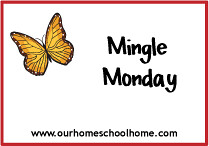Now, since flowers are stationary, they need help transferring their pollen. Some flowers attract insects and birds to help with the job. As I was taking a group on a tour of Secrest Arboretum this Monday, we saw one plant that literally had well over a dozen different species of insects hard at the work of pollination. When the insects of birds visit the flower,, they can accidentally rub against the pollen (the yellow stuff in the picture above) and carry it with them to another flower. In the process, they transfer pollen from an anther to a stigma, which pollinates the flower and enables from fruit to grow.
So how do plant attract pollinators? Several ways:
- Displaying brightly colored petals
- Mimicking smells
- Providing nectar (one sweet food source!)
- Mimicking shapes of other objects
- Using designs or tracks to direct pollinators
Just a note: not all plants are pollinated by animals. Some are pollinated by wind or water and still others are self-pollinated.
As I mentioned earlier, this is a perfect time of year to see pollinators hard at work. Take a hike outdoors and challenge the kids to find a flower, describe the parts they can see, and hypothesize about how they think the plant is pollinated. It's also fun to look for pollinators at work....just be sure to look and not touch!
Growing Together is a great resource available from Ohio State University Extension that has a lot of great outdoor-themed lesson plans. Inside, you'll also find great worksheets and detailed pictures of the parts of the flower and tons of other cool resources. Contact your local Extension office to ask about ordering a copy. The following activity is adapted from this book.
Materials needed:
- Cardstock or construction paper
- Scissors
- Q-Tips or other cotton swabs
- Colored chalk or colored sugar
- Glue dots
- Large marshmallows
Directions:
- Have students cut out or color a cardstock or construction paper flower about the size of a hand (this is a top-down view of a flower - so it will look kind of like a symmetrical cloud).
- Attach marshmallow to center of the flower with a glue dot.
- Cut Q-tips in half. Dip cotton-covered end in crushed colored chalk (I use colored sugar like for decorating cookies so I don't have the work of crushing the chalk). Insert other end of Q-Tip into marshmallow, like spokes on a wheel. 5-6 "spokes" per flower is good. I suggest making a minimum of 2 flowers and using only one color of sugar or chalk per flower.
- Gently moisten the top of the marshmallow (to make it a little "sticky")
- Have students pretend a new Q-Tip is an insect collecting pollen an nectar. As it flies around from one flower to the next, see how is spreads the sugar from the outer anthers (Q-Tips) to the inner stigma (marshmallow). Remember, the pollinator doesn't go directly from anther to anther, it bumps around and explores in teh flower to fins what it is looking for.
- Let them each take turns pollinating each other's flowers.
Other cool facts about pollinator preferences:
- Hummingbirds prefer deep, tube-shaped flowers, especially reds or deep oranges.
- Bats and some moths prefer large, night-blooming flowers, often rotten smelling, and prefer white.
- Bees prefer colorful, scented flowers with UV guides; they see all colors except red and especially prefer blue, purple and white.
- Butterflies prefer deep, tube-shaped flowers or large flowers where they can rest. They prefer red, purple, orange and white.
Other great pollinator resources:
- The Clover & the Bee by Ann Dowden
- Growing Through Changes: Life Cycle of Plants by Alan Rossman
- Partners in Pollination
- Pollinator Partnership (National Pollinator's Week) - 4th - 6th grade curriculum






















